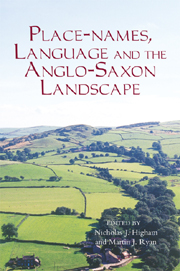Book contents
- Frontmatter
- Contents
- List of Illustrations
- Acknowledgements
- List of Contributors
- Abbreviations
- 1 Place-Names, Language and the Anglo-Saxon Landscape: An Introduction
- 2 The Landscape of Place-Name Studies
- 3 Place-Names as Travellers' Landmarks
- 4 Light thrown by Scandinavian Place-Names on the Anglo-Saxon Landscape
- 5 Language and the Anglo-Saxon Landscape: Towards an Archaeological Interpretation of Place-Names in Wiltshire
- 6 Hunting the Vikings in South Cumbria from Ambleside to Haverbrack
- 7 Viking-Age Amounderness: A Reconsideration
- 8 The Woodland Landscape of Early Medieval England
- 9 The Pre-Conquest Lands and Parish of Crediton Minster, Devon
- 10 Rewriting the Bounds: Pershore's Powick and Leigh
- 11 That ‘Dreary Old Question’: The Hide in Early Anglo-Saxon England
- 12 Boroughs and Socio-Political Reconstruction in Late Anglo-Saxon England
- Index
5 - Language and the Anglo-Saxon Landscape: Towards an Archaeological Interpretation of Place-Names in Wiltshire
Published online by Cambridge University Press: 05 February 2013
- Frontmatter
- Contents
- List of Illustrations
- Acknowledgements
- List of Contributors
- Abbreviations
- 1 Place-Names, Language and the Anglo-Saxon Landscape: An Introduction
- 2 The Landscape of Place-Name Studies
- 3 Place-Names as Travellers' Landmarks
- 4 Light thrown by Scandinavian Place-Names on the Anglo-Saxon Landscape
- 5 Language and the Anglo-Saxon Landscape: Towards an Archaeological Interpretation of Place-Names in Wiltshire
- 6 Hunting the Vikings in South Cumbria from Ambleside to Haverbrack
- 7 Viking-Age Amounderness: A Reconsideration
- 8 The Woodland Landscape of Early Medieval England
- 9 The Pre-Conquest Lands and Parish of Crediton Minster, Devon
- 10 Rewriting the Bounds: Pershore's Powick and Leigh
- 11 That ‘Dreary Old Question’: The Hide in Early Anglo-Saxon England
- 12 Boroughs and Socio-Political Reconstruction in Late Anglo-Saxon England
- Index
Summary
The disciplines of place-name study and archaeology have long been central to our understanding of the Anglo-Saxon landscape. However, place-name scholars and archaeologists have not always seen eye-to-eye and mutual mistrust has occasionally prevailed. In this chapter I aim to demonstrate that the study of place-names in conjunction with archaeology can reveal new and important relationships between places and people in Anglo-Saxon England. Case studies are drawn from Wiltshire, where place-names containing a variety of Brittonic and Old English elements inform our understanding of such topics as the British cultural presence and the form and location of Anglo-Saxon settlements.
Place-Name Study and Archaeology: A Personal View
One need only turn to the introduction to the first edition of Margaret Gelling's Signposts to the Past to discover that place-name specialists and archaeologists have not always appreciated each other's point of view:
archaeologists may feel that philologists lack the practical sense needed for the realistic interpretation of names bestowed by peasant farmers. Philologists, for their part, are acutely aware that historians and archaeologists are embarrassingly disaster-prone when discussing place-names.
As a landscape archaeologist with a keen interest in place-names, I am often frustrated by the apparent tensions between the two fields and wonder where and when the problems evident in the above quotation began. The answer appears to lie with the ‘great revision’ of the 1960s, when place-name scholars sought to distance themselves from the ‘clean sweep’ view of Anglo-Saxon England held by leading archaeologists and historians of the day.
- Type
- Chapter
- Information
- Place-names, Language and the Anglo-Saxon Landscape , pp. 85 - 104Publisher: Boydell & BrewerPrint publication year: 2011

